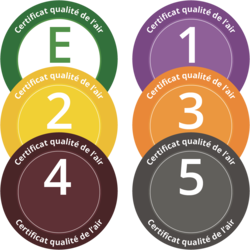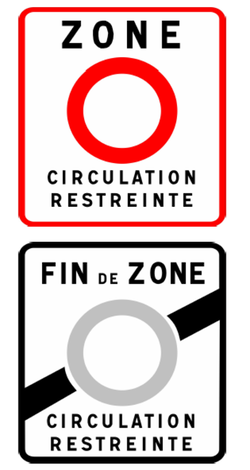Name of the environmental zone: Environmental zone ZFE Lille - France
Date of entry into effect of the zone: 01-01-2025
Type of environmental zone: Permanent
Not allowed to drive (temporarily): Information currently unavailable
Not allowed to drive (permanently): Permanent driving ban for trucks and vans with sticker 4, 5 and without sticker.
Fines: 68-450 €
Area/extension of the environmental zone: The environmental zone covers 95 municipalities of the Métropole Européenne de Lille.
Contact of the environmental zone and exceptions: Information currently unavailable
Exemptions: Doctor, Fire brigade, Military, Police car, Customs, Snow plough, Public bus and Ambulance
Name of the environmental zone: Environmental zone Lille (Greater Lille) ZPA central - France
Date of entry into effect of the zone: 18-07-2017
Type of environmental zone: temporary, weather-related air protection zone, active when pollution limits are exceeded
Not allowed to drive (temporarily): Vehicles without a badge and vehicles with insufficient badge class, depending on the level and duration of the air pollution peak.
Not allowed to drive (permanently): Information currently unavailable
Fines: 68-450 €
Area/extension of the environmental zone: The Greater Lille ZPA air protection zone includes the following municipalities: Lille, Hellemmes, Lambersart, Lezennes, Lomme, La Madeleine, Marcq-en-Baroeul, Marquette-Lez-Lille, Mons-en-Baroeul, Ronchin, Saint-André-lez-Lille and Sequedin, Faches-Thumesnil, Haubourdin, Lesquin, Loos, Noyelles-lès-Seclin, Seclin, Villeneuve d'Ascq and Wattignies.
The main axes A1, A22, A25, N227 and M652, which pass through the Greater Lille ZPA air protection zone, will not be affected by driving bans.
Contact of the environmental zone and exceptions: Information currently unavailable
Exemptions: Doctor, Fire brigade, Military, Police car, Customs, Snow plough, Public bus and Ambulance
Name of the environmental zone: Environmental zone Lille (Greater Lille) ZPA extends - France
Date of entry into effect of the zone: 18-07-2017
Type of environmental zone: temporary, weather-related air protection zone, active when pollution limits are exceeded
Not allowed to drive (temporarily): Vehicles without a badge and vehicles with insufficient badge class, depending on the level and duration of the air pollution peak.
Not allowed to drive (permanently): Information currently unavailable
Fines: 68-450 €
Area/extension of the environmental zone: The extended ZPA air protection zone Greater Lille includes the following municipalities: Croix, Mouvaux, Roubaix, Tourcoing et Wasquehal, Halluin, Hem, Lannoy, Lys-lez-Lannoy, Neuville-en-Ferrain, Roncq, Wattrelos.
The main axes A1, A22, A25, N227 and M652, which pass through the Greater Lille ZPA air protection zone, will not be affected by driving bans.
Contact of the environmental zone and exceptions: Information currently unavailable
Exemptions: Doctor, Fire brigade, Military, Police car, Customs, Snow plough, Public bus and Ambulance
Environmental zone ZFE
Do I need stickers or registrations?
To enter the low emission zone, each vehicle concerned requires a valid French environmental sticker (Certificat qualité de l'Air). Otherwise, a fine of 68 euros to 375 euros is to be expected.
What is a ZFE zone?
The ZFE zones (Zone à Faibles Émissions), which were still called ZCR zones from 2016 to the end of 2019, are fixed zones that can be identified by traffic signs.
The establishment of a ZFE in France is the responsibility of the respective city or municipality and is regulated by the national decree Décret ZCR 2016-847 of 28.06.2016. After a 6-month legal consultation procedure, which also provides for a right of participation of affected persons, the zone can come into force.
In order to be able to travel in the ZFE environmental zones established by cities or municipalities in France, a Certificat qualité de l'Air is then required, which is allocated to 6 categories.
The respective city or commune determines which sticker classes may enter when. On an additional sign, under the actual ZFE sign, days and times are indicated at which one may enter with a certain French vignette.
In the long term, more and more vignette categories are being excluded from entering low emission zones, so that in some years only categories E and 1 will be allowed to enter.
In a ZFE zone, vignette colours are permanently excluded and do not depend on the respective weather conditions. However, it is possible that a ZFE and a ZPA zone overlap. If driving bans are then imposed within the ZPA zone due to the weather, these also apply to the ZFE/zone. In this case, the rules of the ZPA also apply to the ZFE zone.
However, if the ZFE zone is not within a ZPA zone, this case cannot occur and the rules are unchangeable.
How do I recognize the low emission zone?
The beginning and end of the environmental zones are marked with signs. This shows a red circle as a prohibition sign with the remark "Zones à Circulation Restreinte" (Restricted Zone). Exactly who may or may not enter the zone is not indicated by the entry sign.
In our Green Zones App we have a detailed map of each low emission zone. So you can easily see the boundaries and avoid penalties.
Are there other low emission zones in France?
Yes, a lot of them. France has over 30 different environmental zones. These differ in ZFE (permanent), ZPA (temporary) and ZPAd (temporary département) zones.
In our Green Zones App we have gathered together all the low emission zones in Europe and presented them clearly.
Environmental zone ZPA
Do I need stickers or registrations?
If there is a peak in air pollution and the ZPA zone is activated, each affected vehicle requires a valid French environmental sticker (Certificat qualité de l'Air) to enter the low emission zone. Otherwise, a fine of between 68 euros and 375 euros is to be expected.
You can find out whether a ZPAd zone is active and which vignette is affected by the driving ban in our Green-Zones App.
What is a ZPA zone?
ZPA zones ("zones de protection de l'air") do not apply permanently, but are only active during bad weather and high air pollution. They can cover the areas of entire large municipalities (known as "metropolitan areas" in French) or a specific geographical area. The outlines of each air protection zone are therefore precisely defined in advance.
Since ZPA zones are only valid in the event of a peak in air pollution, the traffic restrictions laid down in a decree only apply if predefined air pollution limits are exceeded. In this case, certain vignette colours are excluded from traffic in order to reduce pollutant emissions. For each air protection zone, recommendations have been drawn up in advance as to which vignette colours should be excluded in the event of severe air pollution. However, in the specific case of air pollution this is always decided by the prefect of the department first.
The mostly large ZPA air protection zones within a department are usually not signposted. In the 95 departments of continental France, it is therefore almost impossible for non-residents to see the exact extent of a ZPA air protection zone. In accordance with article R411-19 of the French Road Code, the decision to create an air protection zone and to define the local rules applicable there falls to the prefect of each department. Once the ZPA zone has been decided, it is legally published in a décret issued by the prefect.
The traffic restrictions decided in a CPA do not come into force on the same day as they are announced. They are usually announced in the afternoon or evening for the following day. The driving bans then apply throughout the ZPA. In case there is an urban ZCR zone within the ZPA zone, its rules are overridden during an air pollution peak. Only after the end of the air pollution peak will the permanent traffic restrictions for vignette categories apply again within the ZCR zone.
How do I recognize the low emission zone?
ZPA zones are only activated temporarily. The size and dimensions of the zone are completely individual. This is determined by the respective prefect, depending on the intensity of air pollution. Therefore there are no special signs for ZPA zones.
The situation is different for the ZFE zones. There, the beginning and the end of the environmental zones are marked with signs. This shows a red circle as prohibition sign with the remark "Zones à Circulation Restreinte" (Restricted Zone). Who exactly is allowed to enter or not is not indicated by the entry sign.
In our Green Zones App we have a detailed map of each low emission zone. So you can easily see the boundaries and avoid penalties.
Are there other low emission zones in France?
Yes, a lot of them. France has over 30 different environmental zones. These differ in ZFE (permanent), ZPA (temporary) and ZPAd (temporary département) zones.
In our Green Zones App we have gathered together all the low emission zones in Europe and presented them clearly.
Good to know...
All current driving bans and further information are available in our Green-Zones App.
Are night-time environmental zones coming?
The Berlin Green Party recently presented a proposal to equalise the traffic congestion in the capital. The idea is to shift delivery and commercial traffic to the night-time hours. According to Antje Kapek, transport spokesperson for the Greens, this proposal should help to ensure that delivery vehicles, refuse collection, care services and doctors get stuck less in congested and parked-up streets during the day. Low-noise and low-emission lorries could increasingly drive into cities at night and on special routes.
Bicycle instead of car - Paris in transition
A study by a public foundation has shown that more than one in ten journeys in Paris and the surrounding area are made by bicycle. This is a remarkable increase compared to 14 years ago, when less than one in thirty journeys were made by bike. Paris seems to have been endeavouring to change its transport policy for years. With more cycle paths and cycle lanes, fewer car parks and higher parking charges, the city is trying to promote cycling and reduce car traffic. But what does this mean for the existing low emission zone?



![[Translate to Englisch:]](https://www.green-zones.eu/fileadmin/_processed_/8/3/csm_screenshot_2024-04-18_125614_c7d9eca4a5.png)
![[Translate to Englisch:]](https://www.green-zones.eu/fileadmin/_processed_/2/0/csm_screenshot_2024-04-18_121908_5e1053efaf.png)